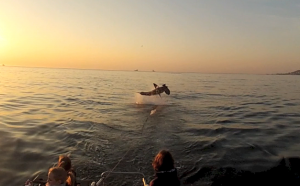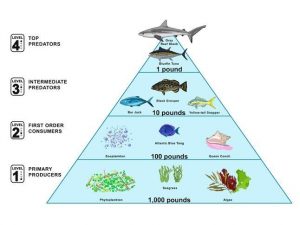Great white sharks are one of the oceans most notorious shark species, a top apex predator with one of the most remarkable and eye-catching predatory hunting behaviors documented in the natural world, the Polaris breach.

White sharks have often split the publics opinions, filling some people with inquisitive questions and fascination whilst being the source of fear for many others. Whatever your thoughts on the white shark, there is no denying that they are a powerful, perfectly evolved hunting specimen which deserves great respect. However, there is a growing notion that there may be some competition for the title of ‘king of the ocean’, this competition comes in the form of the killer whale.
White sharks and killer whales are both apex predators in the marine ecosystems and play important roles in the health of the oceans through “top-down” predatory regulation. These two species compete for similar resources at the top of the trophic pyramid, and from time to time overlap in their habitat use.

Both Killer Whales and White sharks have a worldwide distribution, white sharks aggregate in the temperate waters around Australia, New Zealand, USA and South Africa and transient killer whales are frequently sighted passing through these areas. White sharks have been known to reach a maximum total length exceeding 6 m and over 2500 kg in weight, whilst Killer whales can grow to more than 9 m and can weigh in at over 5,400 kg making them a force to be reckoned with. Killer whales are an incredibly smart species which mostly operate in social groups with team work and intricate communication to hunt their prey.

There are historical records of competition and conflict between these two apex species, records show several shark species to be prey of killer whales including blue sharks, Mako sharks, seven gill sharks and white sharks.
During 2017 you may have heard about the three white sharks that washed up along the coast of South Africa soon after the sighting of two killer whales moving through the area. On examination one of the individuals had a very clean slice between the pectoral fins with the entire liver having been removed, another one was missing its stomach and testis as well as the liver. White shark livers are huge, representing a third of the sharks’ total weight and hold highly nutrient squalene. The manner in which these shark carcasses had been killed and efficiently de-livered was concluded to be strong evidence towards the likely verdict that killer whales were responsible for these mysterious washed up white shark’s.
Killer whales therefore seem to be the only known predator of white sharks and this fierce competition between the two species has no doubt evolved various recognition and avoidance of each other’s presence and potential threat. This no doubt leads to evolutionary adaptations and instinctive behaviors which may offer fascinating insight into the battle for ‘King of the oceans!’ For more info check out this link

For more blogs, news and marine action follow us @caperadd
Want to join our marine biologist field course? Check it out here
2 Comments
نهنگ قاتل – شرکت دانش بنیان مرصاد · March 19, 2021 at 9:18 pm
[…] نهنگ قاتل یا کوسه ی سفید! […]
آینه ی صوتی – شرکت دانش بنیان مرصاد · March 27, 2021 at 2:24 pm
[…] نهنگ قاتل یا کوسه ی سفید! […]